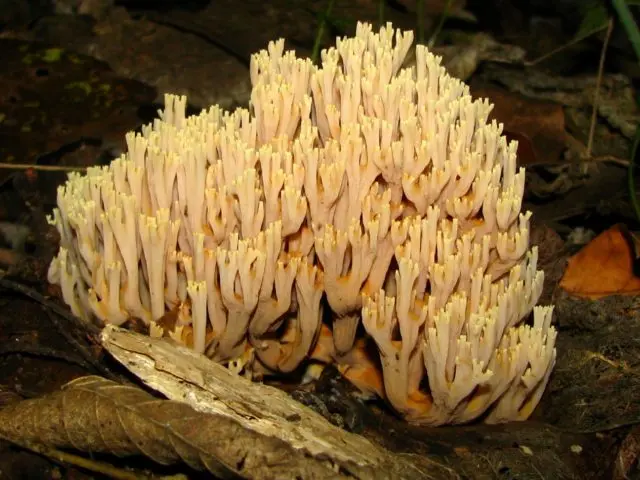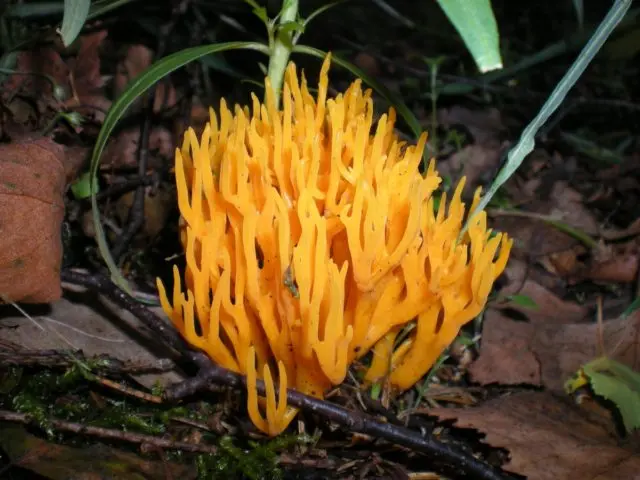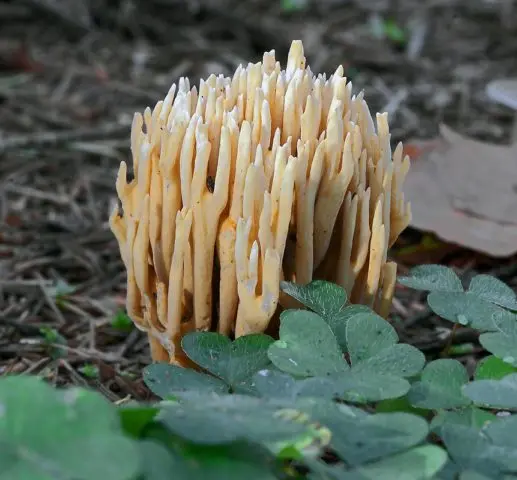Contents
Rogatik straight or hard ramaria – an unusual type of mushroom, similar to a bizarre coral or deer antlers. In various catalogs, it is classified as a member of the Gomfov, Lisichkov, Rogatikov or Ramari family.
Where straight horns grow
The straight horn is found in conifers and mixed forests of North America and Eurasia. In Our Country, it grows in the Far Eastern and European parts. Prefers to settle in spruce forests and pine forests. The fruit body of the fungus develops on rotting wood, in particular on old trunks ingrown into the soil, less often a straight horn can be seen on the ground under shrubs. It is the only member of the genus Ramaria that grows on trees. Fruiting occurs in the summer-autumn period, the species can grow both singly and in rows.
What do straight horns look like
Rigid ramaria is a set of branched branches fused together on a thin and dense base. The color of the shoots varies from light orange and peach to ocher brown, the tips are light yellow. With age, the tops dry out and turn brown. When pressed or damaged, the flesh acquires a wine-red hue, the same process can be observed on the cut.

The height of the fruiting body is 5-10 cm, the branches grow in parallel and mainly upwards. The diameter of a straight horn is usually half the height. The leg has a light yellowish tint; in some specimens, a blue-lilac tint can be seen. The diameter of the stem rarely exceeds 1 cm, the height varies from 1 to 6 cm.
The mycelial strand, which fixes the fungus on the substrate, is located at the base of the stem. In appearance, it resembles thin snow-white threads. At the point of contact of the fruiting body with wood or soil, an accumulation of mycelium can be observed.
In various reference books, the straight horn is sometimes found under other names:
- hard ramaria (Ramaria stricta);
- ramaria straight;
- Lachnocladium odorata;
- Clavaria stricta;
- Keys of syringes;
- Clavaria pruinella;
- Clavariella stricta;
- Coral tight;
- Merisma tight.
Is it possible to eat straight horns
Ramaria straight is considered inedible. The pulp has a pleasant aroma, however, it tastes bitter and spicy. The structure of the pulp is elastic, dense, rubber-like.
How to distinguish straight horns
The straight horn can be confused with sticky calocera (Calocera viscosa). On closer examination, significant differences can be found between the species. The color of the sticky calocera is more saturated, almost flashy. The fruiting body may be bright yellow or bright orange. The height of the calocera does not exceed 10 cm. Numerous branches branch dichotomously, that is, the main axis bifurcates and stops its own growth. Such branching is repeated many times, as a result of which the fungus becomes like a bush, coral or a frozen fire. Refers to inedible.

Common ramaria (Ramaria eumorpha) is the closest relative of the straight hornbill. The species are very similar in appearance. The fungus is distributed throughout the Federation, where there are coniferous forests. Fruiting from late July to early October. It grows in groups on spruce or pine litter, often forming the so-called “witch circles”.
The vertical branches of the common ramaria are characterized by sharper tips relative to the straight ramaria. The fruit body is represented by a dense bush 1,5-9 cm high and up to 6 cm in diameter. The mushroom is evenly colored in light ocher or ocher-brown color, numerous thorns and warts are present on the surface of the branches.

Artomyces krynochkovidny (Artomyces pyxidatus) can also be mistaken for a straight horn. The species has vertical coral-like branches. The fruit body is painted in an ocher-yellowish calm color. The clavicorona can be distinguished from the straight horn by its size: sometimes it grows up to 20 cm in height. Another difference is the characteristic crown-shaped tips, from a distance reminiscent of the battlements of a medieval castle. The habitats of the species are also different. Unlike the straight hornwort, the klavikorona loves to grow on rotting hardwood, especially on old aspen logs.

Conclusion
The straight horn is an interesting representative of the mushroom kingdom. Along with other related species, it is undoubtedly an adornment of forests.









